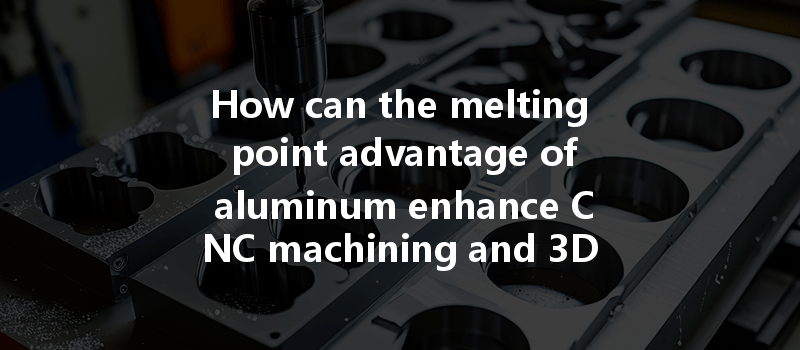Did you know that aluminum is one of the most recycled materials globally, maintaining its properties without degradation? This extraordinary characteristic is just one of the many reasons why the demand for aluminum in manufacturing processes, especially CNC machining and 3D printing, is surging. With its favorable melting point, aluminum presents unique opportunities to enhance efficiency and product quality in these modern fabrication techniques.
As industries shift towards more sustainable practices, the role of aluminum in both CNC machining and 3D printing is gaining momentum. Its low density, corrosion resistance, and excellent strength-to-weight ratio make it a preferred choice for many applications. However, its melting point property opens up a realm of possibilities that can significantly improve fabrication processes.
In this blog, we will dive deep into the melting point of aluminum, its implications for CNC machining and 3D printing, and provide detailed strategies for leveraging this advantage in modern manufacturing.
The Basics of Aluminum’s Melting Point
Aluminum has a relatively low melting point of about 660 degrees Celsius (1,220 degrees Fahrenheit). This property not only simplifies the machining process but also allows manufacturers to implement more intricate designs without the thermal stresses seen in higher-melting-point metals.
Understanding aluminum’s melting point helps manufacturers create predictable, efficient processes. The key is to maintain optimum temperatures that prevent excessive thermal expansion or distortion of the material.
Why Aluminum is Ideal for CNC Machining
CNC (Computer Numerical Control) machining has revolutionized the manufacturing landscape, enabling precise cutting, shaping, and molding of materials. Aluminum tends to be very friendly to CNC machining due to several factors:
The Benefits of 3D Printing with Aluminum
When we talk about 3D printing, aluminum’s unique characteristics take center stage. Here’s how aluminum offers a competitive edge in additive manufacturing:
Techniques to Exploit Aluminum’s Melting Point Advantage
Now that we understand the properties of aluminum and its benefits in CNC machining and 3D printing, let’s discuss some specific techniques to exploit its melting point effectively.
Maintaining the right temperatures during milling and turning operations is critical. Strategies to consider include:

While the melting point of aluminum is lower than many materials, heat treatment processes such as aging can enhance its mechanical properties. Heat treatment helps in hardening aluminum alloys, allowing for better performance post-manufacturing.
Choosing an aluminum alloy tailored to your application can greatly influence machining outcomes. Alloys like 7075 offer higher strength, while 6061 is more versatile and easier to machine. Evaluate your application requirements and pick the right alloy with suitable melting points and properties.
Utilizing post-processing methods like anodizing or powder coating can enhance corrosion resistance and surface finish while taking advantage of the low melting point for quicker re-melting during surface treatments.
Real-World Applications
Understanding the practical applications of aluminum in CNC machining and 3D printing helps illustrate its significance. Here are notable fields where aluminum shines:
Aerospace Industry
Aluminum’s strength-to-weight ratio has made it a staple in aerospace components, from fuselage sections to internal components. Its melting point advantage allows for the efficient manufacturing of complex parts that can withstand extreme conditions while minimizing weight.
Automotive Sector
With electric vehicles and fuel-efficient designs taking precedence, manufacturers implement aluminum to reduce overall vehicle weight, enhancing performance and efficiency. High-performance, machined aluminum components are crucial for engines and body structures.
Consumer Electronics
From smartphones to laptops, the use of aluminum in casings and internal components provides not just aesthetic appeal but also durability. Manufacturers employ both CNC machining and 3D printing techniques to create intricate parts with great precision.
Medical Devices
In the medical field, aluminum applications include surgical instruments and equipment housings. Its lightweight nature and biocompatibility make it an excellent candidate for medical manufacturing, with precise machining ensuring safety and reliability.
: Harnessing the Power of Aluminum
The melting point advantage of aluminum provides significant opportunities in CNC machining and 3D printing. By understanding and exploiting these properties, manufacturers can not only enhance production efficiency but also improve the quality of the final products.
Whether you’re in the aerospace, automotive, or medical field, the implementation of aluminum in your production processes stands to offer a competitive edge. With continued advancements in machining technologies and 3D printing techniques, the potential applications for aluminum are limitless.
As you reflect on the transformative role of aluminum in manufacturing, consider how leveraging its melting point advantage can lead to innovative solutions and greater sustainability within your projects. The insights shared in this blog not only highlight the benefits of aluminum but also emphasize the importance of embracing modern technologies to drive efficiency and innovation in manufacturing.
Remember, the future of manufacturing isn’t just about using materials; it’s about understanding them, and aluminum presents an incredible opportunity that you don’t want to overlook.






